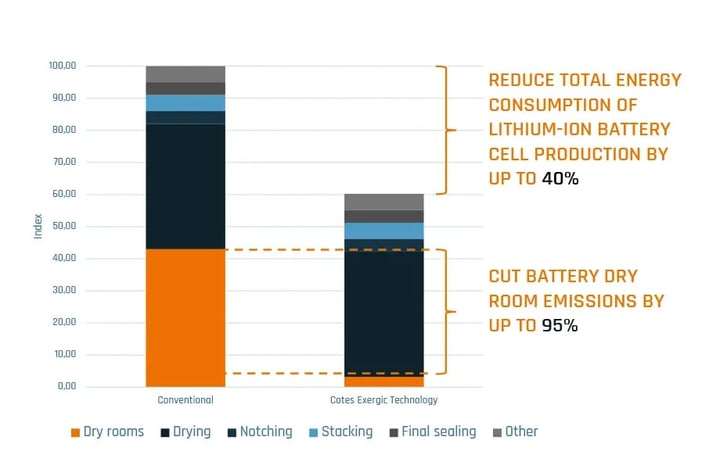
|
In December 2020, the European Commission proposed a new battery regulation aimed at setting sustainability requirements throughout the entire battery product life cycle. In February 2022, the Committee on the Environment, Public Health, and Food Safety (ENVI) adopted and voted in favour of the proposal. Supported by MEPs, the new regulatory framework will be a key driver in the EU battery market and a key differentiator for the EU in the global battery market [europarl.europa.eu]. On December 9th, 2022, the EU Parliament and the Council reached an agreement to make all batteries manufactured in the EU more sustainable, circular, and safe. The new law will advance both the circular economy and the EU's zero-emission aspirations. The agreement still needs to be formally approved before entering into force. |
WHY IS THE NEW EU BATTERY LEGISLATION IMPORTANT?
The new EU legislation will shape the entire battery industry with key sustainability provisions such as carbon footprint transparency, supply chain due diligence, mandated recycling levels, and more guidance on industry practices.
In short, the legislation will set out new standards for sustainability and ethics within the global battery industry, and in return, the battery industry will have to:
- Use clean (sustainable) energy in battery production and have more carbon footprint transparency
- Implement sustainable sourcing of raw materials and ensure supply chain due diligence
- Facilitate better end-of-life handling and comply with mandated recycling levels
NEW RULES FOR CLEAN ENERGY IN BATTERY PRODUCTION
With an expected growth of lithium-ion battery demand in Europe, meeting this demand with batteries produced on a fossil-fuel power grid can lead to a CO2 footprint of about 100 million tonnes per year. In contrast, by embracing renewable energy and circularity, it is possible to cut the carbon footprint by one-tenth.
The European Commission has found a simple yet effective way to encourage the adoption of renewable energy for battery manufacturing through:
- Carbon footprint labelling
- Ban on batteries with the highest carbon intensities
- Efficient recycling
- Use of recycled materials in battery production
- Improved practices for raw materials sourcing
Timeline:
Together, the European Commission and the European Parliament Environment Committee have proposed introducing requirements in three steps for batteries placed on the EU market, regardless of where they have been produced. Proposed dates of implementation from the European Commission (EC) and European Parliament Environment Committee (EP):
|
July 1, 2024 |
July 1, 2025 (EP) Jan 1, 2026 (EC) |
January 1, 2027 (EP) July 1, 2027 (EC) |
| Carbon Footprint declaration requirements | Carbon footprint performance class labels | Ban on the worst-performing batteries |
SUSTAINABLE BATTERY CELL PRODUCTION
How do you make your battery cell production sustainable?
The Problem
In battery cell production, 43% of the process energies stem from running the battery dry rooms (page 20 at ivl.se).
Battery dry rooms are, therefore, the main contributor to the high CO2 footprint in battery cell manufacturing when they use conventional dehumidification systems that require large quantities of gas and/or electricity to run the dehumidifiers to keep the dry room dry. The consumption from these conventional gas and electric-only dehumidifiers contributes up to 8,1% of the total CO2 footprint of the battery.
The Solution
However, there is a more sustainable and energy-efficient alternative. Cotes Ultradry dehumidifiers equipped with the Cotes Exergic Technology enable a combination of sustainable energy sources (waste heat, heat pumps, or solar thermal energy) at low temperatures that can reduce the net energy consumption for running dry rooms by up to 85% and reduce the battery dry room CO2 emission by up to 95%.
That is a reduction of the total CO2 footprint of batteries by 7,7%.
SUSTAINABLE SOURCING OF RAW MATERIALS
Raw material sourcing is complex and bears a high environmental and societal footprint. The mining and exploitation of some battery minerals can be associated with adverse environmental impacts, human rights violations, and poor worker protection.
The lithium-ion batteries of electric vehicles (EVs) require cobalt and natural graphite – this means that the EU will need up to 18 times more lithium and 5 times more cobalt by 2030, and nearly 60 times more lithium and 15 times more cobalt by 2050, compared to the current supply to the whole EU economy.
It is, therefore, important that Europe commits to a determined approach to sourcing raw materials sustainably, encompassing environmental, ethical, and social aspects – particularly for lithium, nickel, graphite, and cobalt.
END-OF-LIFE HANDLING AND RECYCLING
Collection rates of Li-ion batteries in Europe are low and recycling technology is challenging and costly. This is why it is important to have requirements relating to the operations of repurposing and remanufacturing for a second life of EV batteries, ultimately increasing collection rates for Li-ion batteries, especially cobalt.
The goal is for EV batteries with internal storage to declare the content of recycled cobalt, lead, lithium, and nickel contained therein, leading batteries to contain minimum levels of recycled content (12% cobalt; 85% lead, 4% lithium, and 4% nickel by 2030 and 20% cobalt, 10% lithium and 12% nickel by 2035.
BATTERY PASSPORT
The proposed regulation from 2020 also mentioned a battery passport for each manufactured battery which was later updated in the EU Battery Regulation Amendment in March 2022. The battery passport is an electronic record with information specific to the battery it has been created for. Besides industrial and electric vehicle batteries, the Amendment also obliges light means of transport batteries, such have electric bikes or scooters, to have a battery passport by 1st, January 2026 in order to be listed in the European Market.
To ensure continuous availability of the battery passports, all batteries shall have a QR code printed or engraved on them and shall be updated if any changes occur to the battery or its use in the value chain. The QR code shall link to an online system with publicly available information about the value performance, durability parameters, and the state of health of the battery.
The battery passport contributes to the sustainability purpose of the regulation in several ways:
- Accurate, trustworthy, and immutable battery information regarding ESGE (Environmental, Social, Governance, and Economic) indicators in the battery value chain
- The requirement to keep updating the battery passport will encourage more environmentally friendly usage of the product
- Transparency about the production of the batteries and their usage will allow consumers to make more informed and eco-friendly buying decisions
- Validating and tracking progress on the pathway to sustainable, responsible, and resource-efficient batteries
- Emerging new business models based on data sharing
Additionally, the battery passport might serve as a competitive advantage in the increasingly competitive sustainable battery industry. By exposing the details of battery manufacturing to the general public, companies will benefit from trying to have the most sustainable production possible. Cotes energy-efficient dry-air solutions can to a high degree contribute to the competitive advantage of sustainable battery manufacturing in the ways described above.
ABOUT THE NEW EU LEGISLATION
%2c%20rapporteur-min.webp?width=827&height=465&name=Regulation%20concerning%20batteries%20and%20waste%20batteries%20statement%20by%20Simona%20BONAF%C3%88%20(S%26D%2c%20IT)%2c%20rapporteur-min.webp) Image: Simona BONAFÈ, Vice President - Group of the Alliance of Socialists and Democrats in the European Parliament, giving a statement on the regulation concerning batteries and waste batteries. [source europarl.eu]
Image: Simona BONAFÈ, Vice President - Group of the Alliance of Socialists and Democrats in the European Parliament, giving a statement on the regulation concerning batteries and waste batteries. [source europarl.eu]
“For the first time in European legislation, the Battery Regulation lays down a holistic set of rules to govern an entire product life cycle, from the design phase to end-of-life. This creates a new approach to boost the circularity of batteries and introduces new sustainability standards that should become a benchmark for the entire global battery market. Batteries are a key technology for fostering sustainable mobility and for storing renewable energy. To achieve the objectives of the Green Deal and to attract investment, co-legislators need to move for a swift adoption of clear and ambitious rules and timelines," says Simona BONAFÈ, Vice President - Group of the Alliance of Socialists and Democrats in the European Parliament. [source]
With an increasing global battery demand, the European battery market presents the European economy with an unmatched opportunity. The European Commission has estimated the new European battery value chain to be worth €250 billion a year by 2025 [eba250.com].
“Clean energy is the key to the European Green Deal, but our increasing reliance on batteries in, for example, transport should not harm the environment. The new batteries regulation will help reduce the environmental and social impact of all batteries throughout their life cycle. Today's proposal allows the EU to scale up the use and production of batteries in a safe, circular and healthy way", said Executive Vice-President for the European Green Deal Frans Timmermans. [ec.europa.eu]
|
If you are a car or battery manufacturer that wants to go green(er) and save costs, then reach out to us. Cotes can help you find the right dry-air solution for your facilities and give you the competitive advantage of a more sustainable Li-ion battery that is future-proof with regards to new EU battery legislation. Contact Vincent von Wieding, Head of Battery Manufacturing Unit for more information at vvw@cotes.com. |
|
Are you curious about the potential energy savings for your battery dry rooms? Take a look at our free online calculator below.


.webp)